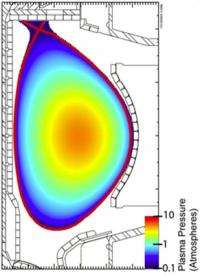I-mode powers up on alcator C-mod tokamak

A key challenge in producing fusion energy is confining the plasma long enough for the ionized hydrogen to fuse and produce net power. Suppressing plasma turbulence is one approach to this, but the resulting increase in energy confinement is usually accompanied by undesirable increases in particle and impurity confinement, which can lead to plasma contamination and ash accumulation—and reduced power. At MIT's Alcator C-Mod tokamak reactor, scientists are investigating I-mode, an improved confinement regime, which may solve this problem.
Tokamak reactors operate by using powerful magnetic fields to confine hot plasma in a doughnut-shaped ring. I-mode describes a set of tokamak operating parameters that create a strong energy barrier near the plasma edge, while still allowing substantial particle and impurity transport across the barrier to reduce plasma contamination.
Until recently, I-mode could only be maintained within a small operational power window to avoid the more conventional H-modes (high containment modes), which have either unacceptable impurity accumulation or edge relaxation oscillations that can result in high power loading on reactor vessel walls.
But through careful plasma shaping, and taking advantage of C-Mod's closed divertor configuration, this operational window has recently been very substantially widened. In the best cases, the plasma remains in a steady-state I-mode operational regime over a span of input power twice as great.
This is particularly important when considering the prospects of applying I-mode operation to the larger ITER project, currently under construction in France, and to future fusion reactors. Initial calculations indicate that ITER could have sufficient heating power to enter into I-mode, and even stay in I-mode following the expected increase in alpha particle heating that would result from the increased plasma pressure. As illustrated in Figure 1, the plasma pressure achieved in I-mode on C-Mod is within a factor of two of that required in ITER to meet its burning plasma mission.
The recent C-Mod experimental results, along with detailed modeling and simulations, including extrapolations to ITER scenarios, will be reported at the 2011 APS-DPP meeting.
Provided by American Physical Society




















